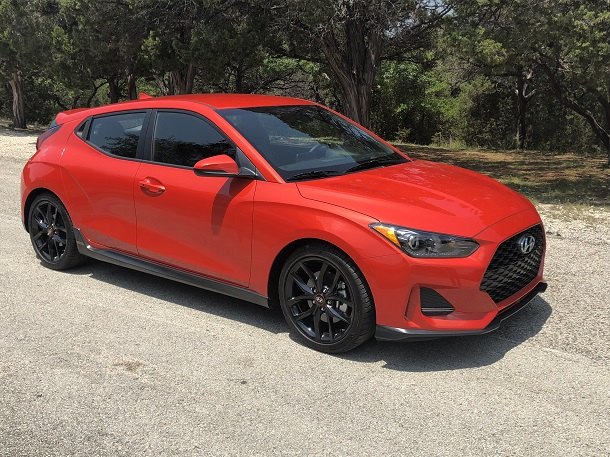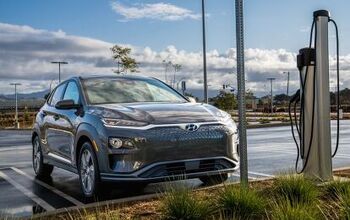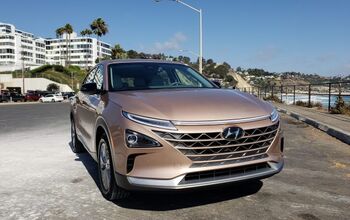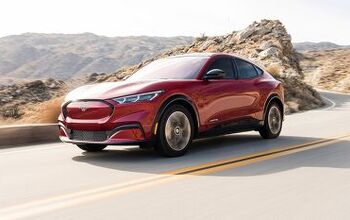2019 Hyundai Veloster First Drive - Improvement Is an Understatement

Some car companies seem to listen to the gripes of us underpaid yet overfed journalist types more closely than others. Hyundai and corporate sibling Kia are particularly good at that – if there’s a consensus among cranky critics about a particular car’s failings, the next generation will almost certainly address the criticisms and improve upon them.
Hyundai’s Veloster has taken a lot of crap from us keyboard knights for being a sporty hatch that lacked in power, had a crashy suspension, and offered so-so handling. Oddly, the unusual three-door body style never seemed to be the biggest complaint (surely, some even like it).
Enter generation two. Hyundai’s made a lot of changes, and every one of them goes towards making the Veloster a better car. Most succeed in that endeavor.
Full disclosure: Hyundai flew me out to Austin, Texas to drive the Veloster. They fed me excellent meals while I was there, and put me in a nice hotel. The company gave out a tchotchke bag (lip balm, corkscrew, playing cards, and a coaster), headphones I’ll never use, and left a beer and chips in the room. Both were good. They also gave me the minibar key, and I made sure to ignore it.
The Veloster skipped the 2018 model year, thanks to a longer than usual 2017 MY. That car offered two 1.6-liter four-cylinder engines, one with a turbo and one without. That’s not the case now. The 2019 Hyundai Veloster lets you pick between a 2.0-liter four-cylinder that makes 147 horsepower and 132 lb-ft of torque and a 1.6-liter turbocharged four-cylinder that makes 201 horsepower and 195 lb-ft of torque. Astute readers will note that the specs of the latter engine match that of the previous gens’ turbo four.
And yet, the R-Spec trim I drove with the 1.6 felt quicker. More on that later, now back to your regularly schedule specs and changes lead-in.
During the press briefing, Hyundai said that it could’ve made the Veloster a two- or four-door model without incurring any additional cost. Yet it stuck with the three-door format. Presumably there’s enough of an audience willing to keep Veloster weird.
Styling isn’t a major departure, as the basic shape stays the same. The biggest change is the front grille, which boasts a new design. LED lighting is available front and rear, and another big chance is a lowered roofline. Hyundai also pushed the A-pillar rearward and gave the car functional air curtains. The rear diffuser is styled to be more aggressive than before, and center tips remain for the exhaust – one for the base motor, two for the turbo. You can also darken the roof if that’s your thing.
The car stays about the same size, and while the new duds are noticeable, keeping the overall shape the same means you know you’re looking at a Veloster right away. It’s a slightly smoother and more aggressive look than before, but not a drastic difference. One cool bit is the hatch release, which is hidden under the rear wiper to give a cleaner look.
When I say the car stayed about the same size, I mean it. Wheelbase and height remain unchanged, while the gain in width is just 0.4 inches. Length climbs by 0.8 inches.
Predictably, that means interior dimensions don’t change much. You gain 0.6 inches of rear headroom and 0.1 inch of front legroom, so you can buy those thicker shoes if you like. You do lose 0.2 inches of rear legroom, though. Cargo volume is 19.9 cubic feet.
The interior is standard Hyundai fare, price-point appropriate with a logical control layout and the loathed (at least by me) tacked-on center stack. Leg and headroom are adequate up front, and my tall frame was OK in the rear, as long as the front seat wasn’t situated all the way back. The exhaust note can be “enhanced” via either setting or by switching drive modes.
“Save the manuals” folks, pay attention: The Veloster is available with a six-speed stick with either motor. Prefer to leave your left foot limp, and you get a six-speed automatic with the base engine, or a seven-speed dual-clutch auto with the turbo. Most importantly, you can get a loaded Turbo trim with all the bells and whistles without having to sacrifice the stick. However, you cannot get a mid-trim manual trans Turbo.
Trims play out like this – you can get a 2.0 or 2.0 Premium, which forces you to drive an automatic. There’s three Turbo trims – R-Spec, Turbo, and Turbo Ultimate.
Ah, the R-Spec. That’s what I spent all day driving. Priced at $22,900 before D and D, the R-Spec is the value performance model. It has a short-throw shifter and 18-inch summer tires are the standard rubber. It gets alloy wheels, Hyundai’s Blue Link connected-car tech, uplevel audio, keyless entry and starting, LED headlights and taillights, a 4.2-inch TFT instrument panel display, alloy pedals, and keyless entry and starting.
So yeah – a stick-shift hatch with performance intent for under $25K. On paper, that’s a shot across the bow at Volkswagen and the Ford ST twins (they’re not dead yet). On paper doesn’t mean bupkiss, though. The road is what matters.
On that road, the R-Spec comes closer to the competition than it ever has. It’s not quite a bargain-priced GTI killer – the upcoming N is probably more suited to slugging it out with that car – but it’s close to being as good as a stick-shift non-GTI Golf when it comes to on-road dynamics. Turn-in is sharp and smooth, and mid-corner adjustments are no issue. The steering is well-weighted and accurate, although it loses some sharpness in mid-corner.
Flicking the stick is a joy, and the clutch is pleasant to use both around town and out in the boonies. Hyundai made a major suspension swap out back, replacing the torsion beam setup with a multilink system that has an aluminum rear carrier. The difference is noticeable – the car still rides stiffly, but the suspension no longer crashes over stuff.
Despite being a little heavier than the previous car and having gained no power, the R-Spec feels faster. Maybe my butt and a stopwatch wouldn’t agree, but I felt that the R-Spec had enough guts for bombing out of a corner. It does need to be in a lower gear, though – you’ll have to downshift to pass.
The R-Spec did annoy in some ways. Engine/wind/tire noise – all invasive. The ride got too stiff at times, and while the Sport drive mode firms things up, it doesn’t offer enough of a difference from the already sporty Normal mode. I rode in the back for a bit, and there are no rear A/C vents back there – which left me struggling a bit with the Texas heat.
My drive partner bemoaned the lack of a few key features available on the other Turbo trims that you can’t get with the R-Spec. For example, you have to move up the line to get a sunroof, or head-up display, or wireless cell-phone charging, or factory nav. At least Apple CarPlay and Android Auto are standard across the board (that means you don’t need nav, if you’re looking to save a buck).
I suspect that some of these features are dropped from the R-Spec in an effort to save weight, which is laudable, but it’s going to cause a dilemma for some buyers, especially with no manual available unless you move up to the Ultimate. Others, of course, will happily sacrifice frills and frippery to save weight – and perhaps have a cheap track car.
I did get about five minutes of wheel time in a loaded Ultimate with the DCT – it was unremarkable around town. A “Smart” drive mode on the automatic transmissions learns your habits over time.
Hyundai is offering the usual available tech, in terms of both comfort/convenience and driver assistance. Apple CarPlay, Android Auto, forward-collision avoidance assistance, and lane-keep assist are standard. Available driver aids include driver-attention warning, blind-spot collision warning, rear cross-traffic collision warning, and high beam assist.
Available comfort/convenience tech includes Blue Link, head-up display, wireless cell-phone charging, smart cruise control, and more run-of-the-mill stuff like Bluetooth and USB.
The trim walk is too detailed to completely list here – I do have a word count to stick to, after all – but some of the same stuff you can get on a mid-grade Turbo is also available on the 2.0 Premium, so cheapskates can still snag some goodies.
Pricing starts at $18,500 for the base 2.0, and the slushbox adds a grand. Go for the auto-only Premium and you’re paying $22,750.
The R-Spec commands just $150 more over that, with the mid-grade Turbo setting you back $25,400. A manual-trans Ultimate is $26,650 and it’s $28,150 for the loaded car with auto. D and D is $885.
I’d be curious to spend some time in the Ultimate manual, but the performance-oriented R-Spec has a lot going for it, if you can live without sunroof, heated seats, BSM, factory nav, and wireless phone charging. It’s also much cheaper than a GTI and a tick under the base price of a Golf SE. The Ultimate starts just above the base GTI, but the GTI gets pricy quick as trims and options are ladled on.
The Veloster presents two dilemmas – it’s good enough to compete with the Golf SE and to be a value alternative to the GTI, but the GTI remains the king of the hot hatch. So the choice is value and unusual body style (Veloster) or ponying up an amount of up to $35K (base price for the Autobahn trim) for what’s probably the best daily-drivable performance hatch. Remember, if a base GTI is enough for you, you can get it for about the same price as an Ultimate manual.
If you choose door number one, you then have another choice – almost $4K more for all the features, with likely a slight sacrifice in performance, or sacrifice some comfort for a little more fun and a smaller car payment?
The thing is, the Veloster once wasn’t even really a consideration when one thought of the hot hatch. Didn’t feel quick enough, didn’t handle as well as the others. Was a fine hatch for commuting, though.
Now, the Veloster is at least in the conversation. Maybe most GTI buyers will still sneer at it, but they shouldn’t. And the upcoming Veloster N isn’t even on the road yet.
The GTI and the Ford ST twins (which are both within price range of the Veloster Turbo) are still better performance cars than the Veloster R-Spec, but the gap is much smaller. Factor in the pricing, and the Veloster is now a part of the mix, and not just the quirky oddball sipping drinks quietly in the corner.
[Images: © 2018 Tim Healey/TTAC]

Tim Healey grew up around the auto-parts business and has always had a love for cars — his parents joke his first word was “‘Vette”. Despite this, he wanted to pursue a career in sports writing but he ended up falling semi-accidentally into the automotive-journalism industry, first at Consumer Guide Automotive and later at Web2Carz.com. He also worked as an industry analyst at Mintel Group and freelanced for About.com, CarFax, Vehix.com, High Gear Media, Torque News, FutureCar.com, Cars.com, among others, and of course Vertical Scope sites such as AutoGuide.com, Off-Road.com, and HybridCars.com. He’s an urbanite and as such, doesn’t need a daily driver, but if he had one, it would be compact, sporty, and have a manual transmission.
More by Tim Healey
Latest Car Reviews
Read moreLatest Product Reviews
Read moreRecent Comments
- 1995 SC I will say that year 29 has been a little spendy on my car (Motor Mounts, Injectors and a Supercharger Service since it had to come off for the injectors, ABS Pump and the tool to cycle the valves to bleed the system, Front Calipers, rear pinion seal, transmission service with a new pan that has a drain, a gaggle of capacitors to fix the ride control module and a replacement amplifier for the stereo. Still needs an exhaust manifold gasket. The front end got serviced in year 28. On the plus side blank cassettes are increasingly easy to find so I have a solid collection of 90 minute playlists.
- MaintenanceCosts My own experiences with, well, maintenance costs:Chevy Bolt, ownership from new to 4.5 years, ~$400*Toyota Highlander Hybrid, ownership from 3.5 to 8 years, ~$2400BMW 335i Convertible, ownership from 11.5 to 13 years, ~$1200Acura Legend, ownership from 20 to 29 years, ~$11,500***Includes a new 12V battery and a set of wiper blades. In fairness, bigger bills for coolant and tire replacement are coming in year 5.**Includes replacement of all rubber parts, rebuild of entire suspension and steering system, and conversion of car to OEM 16" wheel set, among other things
- Jeff Tesla should not be allowed to call its system Full Self-Driving. Very dangerous and misleading.
- Slavuta America, the evil totalitarian police state
- Steve Biro I have news for everybody: I don't blame any of you for worrying about the "gummint" monitoring you... but you should be far more concerned about private industry doing the same thing.








































Comments
Join the conversation
Is this today's CR-X
There is a lesson here for Ford. If you spend the time and resources you can produce a competitive car at a decent price. However, cancelling entire car lines and concentrating on mediocre trucks and SUVs is not the way to go.